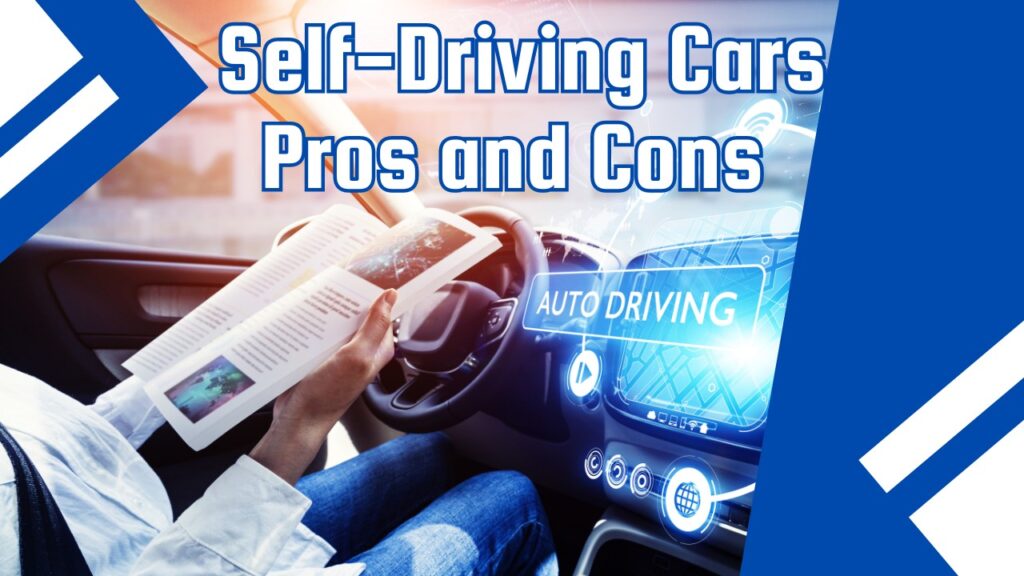Self-driving cars also referred to as autonomous vehicles, are vehicles that can operate without a human driver. Although fully automated vehicles are still being developed, experts believe that they will become ubiquitous shortly.

The introduction of this technology has the potential to greatly change transportation. Self-driving cars offer numerous advantages, including improved safety, increased mobility, and greater efficiency.
But the big question is, should you let a car take the wheel? Let’s break it down, looking at the pros and cons, and see what the future might hold for us with these high-tech rides.
Table of Contents
The Bright Side: Benefits of Self-Driving Cars
First up, let’s talk about the good stuff. Self-driving cars are packed with tech that could revolutionize our daily commutes. Imagine kicking back, sipping your coffee, and catching up on emails while your car smoothly navigates through traffic. Sounds pretty sweet, right?
Safety First
One of the biggest selling points of self-driving cars is safety. These cars are designed to reduce human error, which is a leading cause of accidents on the road.
They use sensors, cameras, and advanced algorithms to detect obstacles, read traffic signs, and even anticipate other drivers’ actions.
This could mean fewer accidents, safer roads, and a big relief for everyone who’s ever felt nervous behind the wheel.
Eco-Friendly and Efficient
Self-driving cars can optimize routes, adjust speed to improve fuel efficiency, and reduce traffic congestion. This not only saves you time but also helps the environment by cutting down on emissions.
Plus, with electric self-driving cars on the rise, we’re looking at a future that’s not just smarter but greener.
Reducing Road Congestion
Connected technology in self-driving cars offers a promising solution to traffic congestion. These autonomous vehicles can communicate both with each other (vehicle-to-vehicle, or V2V) and with city infrastructure, such as traffic lights (vehicle-to-infrastructure, or V2I).
This advanced communication enables self-driving cars to safely travel at closer distances to one another, improving traffic flow.
Additionally, these cars can intelligently choose routes with less traffic. By efficiently managing traffic and avoiding heavily congested areas, this technology helps significantly reduce road congestion and traffic jams.
The Flip Side: Challenges and Concerns
Now, let’s switch gears and talk about some of the concerns surrounding self-driving cars. It’s not all smooth sailing, and there are some valid points to consider before handing over the keys to a bunch of circuits and code.
Tech Glitches and Hacking Risks
Technology isn’t perfect, and self-driving cars are no exception. They rely heavily on software, which means they can be prone to glitches. And let’s not forget the cybersecurity aspect.
The idea of cars being hacked is a real concern, raising questions about privacy and safety. Manufacturers must prioritize security and constantly update their systems to tackle these challenges.
Legal and Ethical Dilemmas
Self-driving cars also open a can of worms when it comes to legal and ethical issues.
Who’s responsible if a self-driving car gets into an accident? How do we handle insurance claims? And then there’s the moral dilemma of decision-making in critical situations.
These are complex questions that need clear regulations and guidelines before self-driving cars can become mainstream.
Reduced Jobs
The advancement of self-driving technology may lead to a significant reduction in driving-related jobs such as truck drivers, taxi drivers, and delivery drivers.
These professions, which currently employ millions of people, could become obsolete in a future where autonomous cars dominate the roads.
This could result in a major economic upheaval, causing a significant number of individuals to lose their jobs.
Looking Ahead: The Future of Self-Driving Cars
So, where does all this leave us? Self-driving cars are definitely on the horizon, but there’s still a road to travel before they become a common sight. The technology is advancing rapidly, but it’s crucial to address the challenges and concerns to ensure a smooth transition.
Gradual Adoption and Ongoing Improvements
We’re likely to see a gradual adoption of self-driving cars, starting with specific applications like delivery services or public transportation. This will give manufacturers and regulators time to fine-tune the technology and establish a legal framework.
Continuous improvements in AI, sensor technology, and cybersecurity will also play a key role in making self-driving cars more reliable and secure.
Embracing Change with Caution
As tech lovers, it’s exciting to witness the evolution of self-driving cars. But it’s also important to approach this change with a healthy dose of caution. It’s about finding the right balance between embracing new technology and ensuring it’s safe, ethical, and beneficial for everyone.
In conclusion, self-driving cars have the potential to transform our lives in many positive ways. From improving safety to reducing our carbon footprint, the benefits are certainly appealing. However, it’s crucial to address the technical, legal, and ethical challenges they present.
By doing so, we can ensure that this exciting technology enhances our lives without compromising our safety or values.
Embracing the Future Responsibly
As we look to the future, it’s clear that self-driving cars will play a significant role in our transportation landscape.
They offer a glimpse into a world where technology takes the wheel, making our journeys safer, more efficient, and more sustainable.
But, like with any major technological advancement, it’s essential to proceed with caution and responsibility.
The Role of Consumers and Regulators
As consumers, we have a part to play in shaping the future of self-driving cars. It’s important to stay informed, ask questions, and voice our concerns.
Regulators, on the other hand, need to establish clear guidelines and standards to ensure the safe integration of self-driving cars into our roads.
This collaborative approach will help maximize the benefits while minimizing the risks.
Staying Open to Innovation
Despite the challenges, it’s important to stay open to innovation. Self-driving cars represent a significant leap forward in technology, and they have the potential to make a positive impact on our lives.
By embracing this change and addressing the challenges head-on, we can pave the way for a future where technology and humanity coexist harmoniously.




